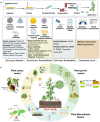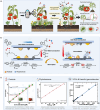Wearable sensor supports in-situ and continuous monitoring of plant health in precision agriculture era
- PMID: 38184781
- PMCID: PMC11123445
- DOI: 10.1111/pbi.14283
Wearable sensor supports in-situ and continuous monitoring of plant health in precision agriculture era
Abstract
Plant health is intricately linked to crop quality, food security and agricultural productivity. Obtaining accurate plant health information is of paramount importance in the realm of precision agriculture. Wearable sensors offer an exceptional avenue for investigating plant health status and fundamental plant science, as they enable real-time and continuous in-situ monitoring of physiological biomarkers. However, a comprehensive overview that integrates and critically assesses wearable plant sensors across various facets, including their fundamental elements, classification, design, sensing mechanism, fabrication, characterization and application, remains elusive. In this study, we provide a meticulous description and systematic synthesis of recent research progress in wearable sensor properties, technology and their application in monitoring plant health information. This work endeavours to serve as a guiding resource for the utilization of wearable plant sensors, empowering the advancement of plant health within the precision agriculture paradigm.
Keywords: in‐situ and continuous; monitoring; plant health information; precision agriculture; wearable sensors.
© 2024 The Authors. Plant Biotechnology Journal published by Society for Experimental Biology and The Association of Applied Biologists and John Wiley & Sons Ltd.
Conflict of interest statement
The authors declare no conflict of interest.
Figures






References
-
- Ahmed, T. , Noman, M. , Gardea‐Torresdey, J.L. , White, J.C. and Li, B. (2023) Dynamic interplay between nano‐enabled agrochemicals and the plant‐associated microbiome. Trends Plant Sci. 28, 1310–1325. - PubMed
-
- Ali, M.M. , Hashim, N. , Abd Aziz, S. and Lasekan, O. (2020) Principles and recent advances in electronic nose for quality inspection of agricultural and food products. Trends Food Sci. Tech. 99, 1–10.
-
- Alkio, M. , Tabuchi, T.M. , Wang, X.C. and Colón‐Carmona, A. (2005) Stress responses to polycyclic aromatic hydrocarbons in Arabidopsis include growth inhibition and hypersensitive response‐like symptoms. J. Exp. Bot. 56, 2983–2994. - PubMed
-
- Amjadi, M. , Pichitpajongkit, A. , Lee, S. , Ryu, S. and Park, I. (2014) Highly stretchable and sensitive strain sensor based on silver nanowire‐elastomer nanocomposite. ACS Nano. 8, 5154–5163. - PubMed
-
- An, J.P. , Liu, Z.Y. , Zhang, X.W. , Wang, D.R. , Zeng, F.C. , You, C.X. and Han, Y.P. (2023) Brassinosteroid signaling regulator BIM1 integrates brassinolide and jasmonic acid signaling during cold tolerance in apple. Plant Physiol. 193, 1652–1674. - PubMed
Publication types
MeSH terms
Grants and funding
- 32125033/National Natural Science Foundation of China
- 32260687/National Natural Science Foundation of China
- Qiankehezhongyindi(2023)001/the Central Government Guides Local Science and Technology Development Fund Projects
- 111Program,D20023/Program of Introducing Talents of Discipline to Universities of China
LinkOut - more resources
Full Text Sources

